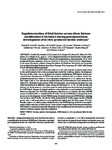Please use this identifier to cite or link to this item:
http://www.alice.cnptia.embrapa.br/alice/handle/doc/1036889Full metadata record
| DC Field | Value | Language |
|---|---|---|
| dc.contributor.author | ARNOLD, D. R. | pt_BR |
| dc.contributor.author | CORRÊA, C. A. P. | pt_BR |
| dc.contributor.author | LORENA, L. L. G. | pt_BR |
| dc.contributor.author | GASPAR, R. C. | pt_BR |
| dc.contributor.author | ROSSI, G. F. | pt_BR |
| dc.contributor.author | IFRAM, A. M. | pt_BR |
| dc.contributor.author | PENTEADO, J. C. T. | pt_BR |
| dc.contributor.author | MINGOTI, G. | pt_BR |
| dc.contributor.author | LOPES, F. L. | pt_BR |
| dc.date.accessioned | 2016-02-15T11:11:11Z | pt_BR |
| dc.date.available | 2016-02-15T11:11:11Z | pt_BR |
| dc.date.created | 2016-02-15 | pt_BR |
| dc.date.issued | 2015 | pt_BR |
| dc.identifier.citation | Pesquisa Veterinária Brasileira, Rio de janeiro, v. 35, n. 7, p. 605-612. jul. 2015. | pt_BR |
| dc.identifier.uri | http://www.alice.cnptia.embrapa.br/alice/handle/doc/1036889 | pt_BR |
| dc.description | e aim of this study was to evaluate the histone modification, H3R26me2 during pre-implantation development of IVP bovine embryos cultured with or without serum supplementation and how these in vitro treatments compared to in vivo embryos at the morula stage. After in vitro maturation and fertilization, bovine embryos were cultured with either 0 or 2.5% fetal bovine serum (FBS). Development was evaluated and embryos were collected and fixed at different stages during development (2-, 4-, 8-, 16-cell, morula and blastocyst). Fixed embryos were then used for immunofluorescence utilizing an antibody for H3R26me2. Images of stained embryos were analyzed as a percentage of total DNA. Embryos cultured with 2.5% FBS developed to blastocysts at a greater rate than 0%FBS groups (34.85+5.43% vs. 23.38+2.93%; P<0.05). Levels of H3R26me2 changed for both groups over development. In the 0%FBS group, the greatest amount of H3R26me2 staining was at the 4-cell (P<0.05), 16-cell (P<0.05) and morula (P<0.05) stages. In the 2.5%FBS group, only 4-cell stage embryos were significantly higher than all other stages (P<0.01). Morula stage in vivo embryos had similar levels as the 0%FBS group, and both were signifcantly higher than the 2.5%FBS group. These results suggest that the histone modification H3R26me2 is regulated during development of pre-implantation bovine embryos, and that culture conditions greatly alter this regulation. INDEX TERMS: Bovine, embryo development, | pt_BR |
| dc.language.iso | eng | eng |
| dc.rights | openAccess | eng |
| dc.subject | H3R26me2 | pt_BR |
| dc.title | Supplementation of fetal bovine serum alters histone modification H3R26me2 during preimplantation development of in vitro produced bovine embryos. | pt_BR |
| dc.type | Artigo de periódico | pt_BR |
| dc.date.updated | 2017-12-29T11:11:11Z | pt_BR |
| dc.subject.nalthesaurus | Cattle | pt_BR |
| dc.subject.nalthesaurus | Embryogenesis | pt_BR |
| dc.subject.nalthesaurus | Fetal bovine serum | pt_BR |
| dc.description.notes | Título em português: Suplementação com soro fetal bovino altera a modificação de histona H3R26me2 durante o período pré-implantacional em embriões bovinos produzidos in vitro. | pt_BR |
| riaa.ainfo.id | 1036889 | pt_BR |
| riaa.ainfo.lastupdate | 2017-12-29 -02:00:00 | pt_BR |
| dc.contributor.institution | DANIEL R. ARNOLD, USP; CAROLINA A. P. CORRÊA, UNESP; LAURA L. G. LORENA, UNESP; ROBERTA C. GASPAR, UNESP; GUILHERME F. ROSSI, UNESP; ADERSON M. IFRAN, UNESP; JOÃO C. T. PENTEADO, UNESP; GISELE MINGOTI, UNESP; FLAVIA L. LOPES, UNESP. | pt_BR |
| Appears in Collections: | Artigo em periódico indexado / Embrapa Unidades Centrais (AI-SEDE)  | |
Files in This Item:
| File | Description | Size | Format | |
|---|---|---|---|---|
| Supplementationoffetalbovine.pdf | 1,45 MB | Adobe PDF |  View/Open |









